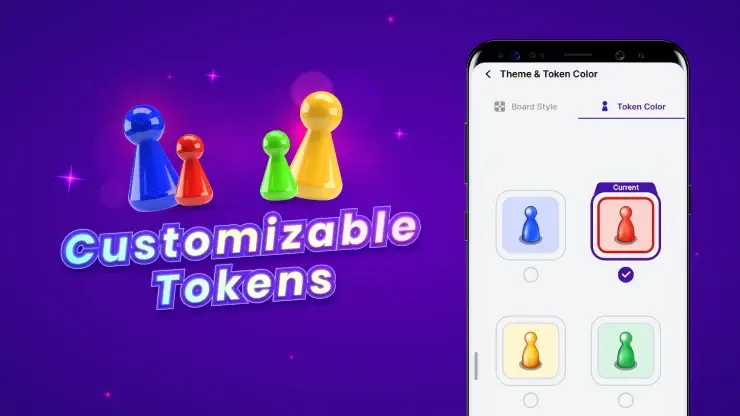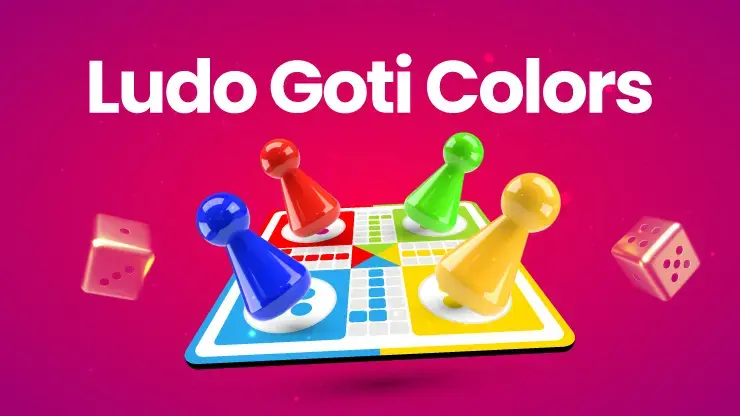Ludo is a timeless board game that creates fondness and friendly battles beyond being a game of dice and moves. The heart of its design lies in its bright colours of goti (token): red, blue, green, and yellow.
These colours are not just aesthetic choices but integral to gameplay and player identity. In both traditional and online versions of Ludo, these hues evoke a sense of belonging, competitiveness, and strategy.
Understanding the meaning of the colours can improve the experience of this game, and serve as life guidance in terms of the colour that suits your personality, and even become the basis of superstitions about which one “wins the most”.
So, by not talking much, let’s dive into the world of Ludo goti colours and their significance.
What Are Ludo Goti Colours?
In Ludo, every player is given a set of four tokens of a particular colour, usually either yellow, blue, green, or red. A home base is represented by each of these colours, which are placed at the board’s four corners. When playing offline, players physically choose from the four colours of ludo goti. Avatars and themes are common in online games where the colours are given automatically or chosen by the player. Besides the increased clarity of vision, every colour helps to identify a player and track their progress.
1. Red
What it Represents: Red symbolizes passion, action, and aggression. Players who choose Red are often seen as assertive, bold, and determined.
Why It Matters: When playing offline, Red usually has the first turn, which gives it an advantage. This symbolism continues even in the online world, as Red enjoyed popularity among the players due to its fiery nature and visibility on online playing boards. The colour itself adds a psychological advantage whereby the opponents are seen as having the red colour that is dominant.
2. Blue
What it Represents: Blue reflects calmness, strategy, and intelligence. It is a colour chosen by thoughtful players who rely on calculated moves rather than rash decisions.
Why It Matters: Blue tokens are visually soothing, reducing the stress of fast-paced decisions in the game. In both offline and online gameplay, players using blue often take the role of the strategist—quietly building their lead and striking at the right moment.
3. Green
What it Represents: Green is the colour of balance, patience, and growth. Players choosing green are often steady, observant, and diplomatic.
Why It Matters: Under the classic board, Green is situated in exact opposition to Red, rendering a balance between the aggression of Red and its serene energy. Green provides a nice contrast of appearance in online games, and players prefer it when the game is relaxed and there is an experience of being concentrated.
4. Yellow
What it Represents: Yellow stands for joy, energy, and spontaneity. It’s the colour of players who bring fun to the game.
Why It Matters: Yellow players are often the wildcards—quick to act, lively, and keeping the opponents on their toes with unpredictable moves. In online versions, yellow is popular among skill-based players or those looking to enjoy the game in a smart way. Its bright colour ensures it stands out, even on small mobile screens.
Online vs Offline Ludo: The Colour Impact
In offline Ludo, the choice of colour is often a ritual—friends fight for their favourite, and families have traditions (like grandma always prefers green). The physical act of placing a red goti on the board builds anticipation and rivalry.
In free ludo online games, the emotional connection with colours persists, but there are added layers—user interfaces, digital themes, and avatars affect how colours are perceived. That said, colours still serve their primary purpose: identity, visual clarity, and emotional connection.
Moreover, many online platforms have introduced colour-based algorithms, making the choice of colour more strategic.
At Zupee, this personal touch goes even further. You get to choose your goti colour, keeping that sense of familiarity alive. Plus, the tokens are designed to match the board themes—so if you pick a cricket or summer-themed board, your tokens adapt to that style, creating a more immersive and visually cohesive gameplay experience.

Can Ludo Goti Colours Impact Your Game Strategy?
Ludo appears to be a game of skills, seasoned players know that strategy plays a significant role—and surprisingly, colours of ludo goti can influence how that strategy unfolds. Let’s discover how:
1. Turn Order Advantage
Red or Blue normally goes first in most of the offline versions, which can help to designate the path of the game. This usually provides the first opportunity for the players to open a goti and secure the board, resulting in a psychological and positional advantage. However, on many online platforms, blue starts first, but the best thing is that all players have equal opportunity as the goti are free to move without waiting to roll a six.
2. Psychological Play
Each colour carries emotional weight. For example, Red players might be encouraged to play aggressively, whereas Blue players might be traditional or diplomatic. This psychological cue may alter the attitude of the players towards making their decisions, whether to kill the goti of an opponent or to keep it safe.
3. Opponent Expectations
Over time, players may develop assumptions based on colour behavior. For instance, someone may expect a “yellow player” to be erratic or a “green player” to play defensively. Understanding these biases allows smart players to fake strategies and break patterns, using their colour as part of the mind game.
Players can assume color behavior with time. An example would be that a person would anticipate a yellow player to be erratic or a green player to be defensive. There is a way to be a smart player by faking strategies and disrupting patterns based on these biases, which are a part of the mind game colour.
4. Online Algorithms & Interface
In online Ludo multiplayer games, some apps assign token colours based on user ID or activity, and while not true, many players believe certain Ludo goti colours get more favourable rolls or safer board positions. The belief itself changes how players react—making them bolder or more reserved depending on the colour assigned.
5. Token Colours and Terminology
Many players are curious about ludo colours, especially because the board visually guides movement and planning. Understanding how token shades stand out on different boards can help players track positions faster and react with better timing.
6. Myths About Lucky Colours
A common question among players is in ludo which colour is lucky, but no colour provides an actual advantage. Still, some choose Red for bold play or Blue for consistency. The belief itself can shape a player’s mindset, making them more confident in certain moves.
Ludo’s charm lies in its simplicity, but the colours of its tokens add meaning far beyond the board. These shades shape strategy, influence confidence, and create small traditions that players carry from one match to another. Many readers also ask what ludo goti in english translates to – the answer is simple: “token.” Yet the emotions attached to each goti colour show how much identity and personality players invest into their game.
It also helps to know how many colours in ludo exist in the standard format. Four colours—red, blue, green, and yellow – form the foundation of the game. These familiar ludo colors support quick visibility, clearer planning, and a more enjoyable experience, whether played offline with family or online with digital themes.
Through all its versions, Ludo has stayed a timeless board game because its tokens, colours, and patterns connect people. These small elements create competition, comfort, and nostalgia—reminding players why they return to the board again and again.

